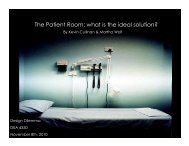The role of physical design and informal communication
The role of physical design and informal communication
The role of physical design and informal communication
Create successful ePaper yourself
Turn your PDF publications into a flip-book with our unique Google optimized e-Paper software.
<strong>of</strong> confidence in their clinical skills was a distinguishing source <strong>of</strong> stress for<br />
inexperienced nurses (Charnley, 1999; Brown <strong>and</strong> Edelmann, 2000), we expected the<br />
stress level <strong>of</strong> the GN to decrease as competency levels increased over the course <strong>of</strong><br />
orientation. However, the findings <strong>of</strong> the current study did not align with this<br />
evidence-based assumption. While the GN competency steadily rose to just under<br />
“Expert” level by week nine, her biological stress showed a highly variable pattern<br />
<strong>and</strong> was actually slightly higher in week nine than in week two. In contrast, Adams<br />
(2008) found a negative relationship between competency <strong>and</strong> stress. At week six,<br />
when the competency was increasing, both the systolic <strong>and</strong> diastolic blood pressure<br />
were decreasing.<br />
<strong>The</strong>re are two possible explanations for the lack <strong>of</strong> a relationship between<br />
competency <strong>and</strong> stress in this study. First is the issue <strong>of</strong> low staffing levels on 6N.<br />
Focused interviews with nurses revealed that there was a shortage <strong>of</strong> nursing assistants<br />
on the unit that dramatically increased the workload <strong>of</strong> RNs. Questionnaire data<br />
confirmed the concern over poor staffing levels. On the section <strong>of</strong> the survey that<br />
measured perceived stress, work load proved to be the most stressful component <strong>of</strong> the<br />
job for the GN as well as the RNs. Given the nation-wide nursing shortage, other<br />
research has explored the effect that poor staffing levels have on nurse stress, <strong>and</strong><br />
these findings are consistent with the observations <strong>and</strong> findings on 6N. <strong>The</strong> American<br />
Nursing Association (2001) posted a national nursing survey online. Quantitative data<br />
revealed that increased patient load <strong>and</strong> decreased time to provide direct patient care<br />
led 40-60% <strong>of</strong> respondents to report frequently skipping meals <strong>and</strong> breaks to care for<br />
patients <strong>and</strong> feeling increased pressure to accomplish their work. Interviewees in the<br />
current study also reported experiencing stress resulting from having to perform the<br />
duties <strong>of</strong> a nursing assistant in addition to the duties <strong>of</strong> an RN because <strong>of</strong> low staffing<br />
levels. This finding corresponds with a study by Buchanan <strong>and</strong> Considine (2002) who<br />
109







